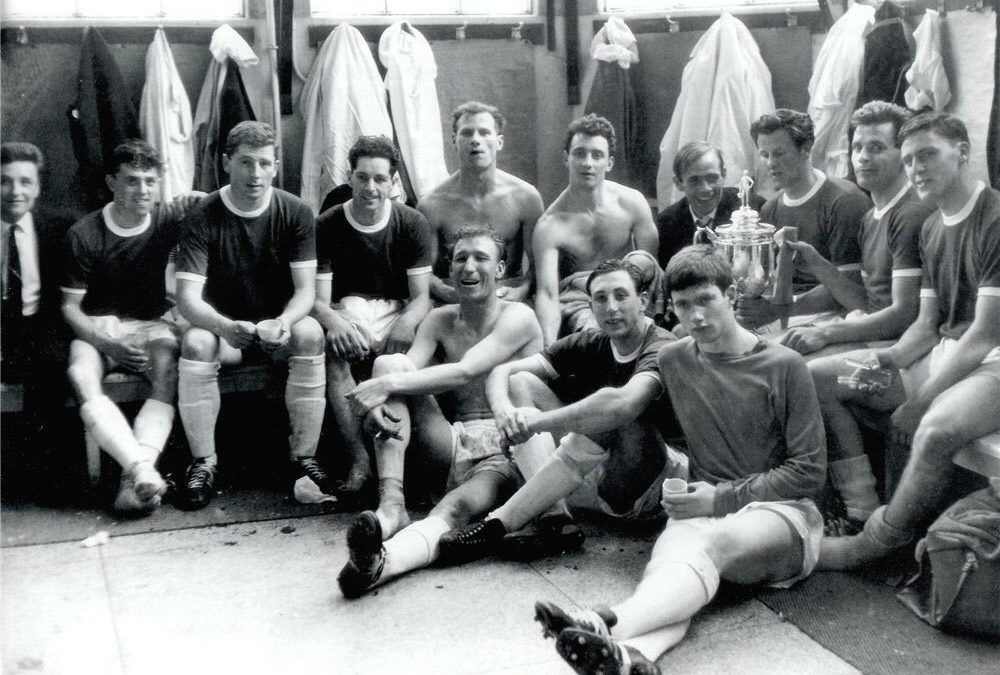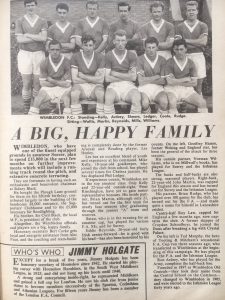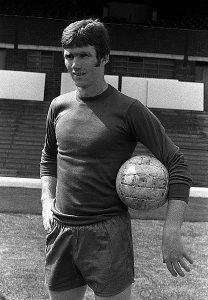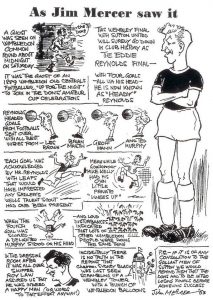THE HISTORY OF WIMBLEDON F. C. Part Two. From the War to Wembley
By Vince Cooper
The return of football after the 2nd World War was gradual and many stadia required extensive work after either being struck during bombing raids or used by the government or army in some way. Plough Lane was no exception with the South stand severely damaged by bombing and fencing around the ground being destroyed which meant that the club had to rely on half-time collections for income as it was impossible to collect gate money.
On the pitch it didn’t take the Dons long to re-establish themselves among the leading lights in the unpaid game. The first full season of play -1945-46 – saw a mid-table finish in the Isthmian League and early exits from both cup competitions.
However 1946-47 was a different story. Following narrow elimination by local rivals Tooting & Mitcham in the FA Cup, the team, fired by goals from Pat Edelston who finished the season having scored 31 times in 34 games, ran through the latter stages of Amateur Cup with comfortable wins over Grays Athletic (3-0) and Tilbury (8-4). Then, in the semi-final The Dons got revenge over Bishop Auckland for their pre-war final defeat, triumphing 4-2 in front of 19,500 fans at Dulwich Hamlet’s Champion Hill ground.
This set up a final for the team, now led by former scoring star and now first-team coach Doc Dowden, against London rivals Leytonstone at Arsenal’s Highbury. Wimbledon went in front through Harry Stannard but the East Londoners hit back to win 2-1 with the Dons’ Frank Lemmer hitting the bar in the final minute.
So the cup run ended in disappointment as did a league campaign in which, after leading in the new year the team were hindered by having to play catch-up matches and faded to a mid-table finish. This was tempered somewhat by a fine financial return which put the club back in the black.
Before the next campaign Edelston was lured away to Sutton United but the goals kept coming, and so did the fans. The first round proper of the FA Cup saw 9,823 cram into Plough Lane to witness a narrow defeat by Mansfield Town and the 2nd round Amateur Cup defeat by Wealdstone drew a crowd of 8,000 whilst thr team progressed to fifth place in the league.
The 1948-49 season saw the club in contention for the Isthmian League crown until the final day of the season but defeat to Dulwich Hamlet in a winner-takes-all battle at Champion Hill saw their rivals claim the crown. There was silverware to come though as 15,250 turned up at Selhurst Park to see Wimbledon hammer Tooting & Mitcham 5-0 to claim the Surrey Senior Cup.

Harry Stannard
Throughout this period one of the key members of the team was Harry Stannard who had joined the club four years before the 2nd World War and would remain with them in some capacity throughout the rest of his life.
Fulham-born Stannard led the forward line with distinction for almost 20 years scoring 333 goals in 426 matches before moving down to play for the reserves. He would later serve as first-team manager and then vice-president before passing away in 2002 at the age of 86.
In the 1949-50 season the club won the London Senior Cup (the match was held over and played at Stamford Bridge in September 1950. At this time there was also work going on at Plough Lane with the South Stand fully restored increasing ground capacity to 25,000.
In 1951 Fulham decided to let youngster Johnny Haynes spend some time at Plough Lane to gain some experience. In a short spell he scored three times in three games including one on his debut against Ilford. He returned to play three more times later in the year and, of course would go on to have a fantastic career with the Craven Cottage club and also to captain England.
The Dons had another future England leader in their ranks with Mickey Stewart in action on the right-wing. Stewart would receive one cap with the England amateur side and would go on to much greater fame as captain of Surrey County Cricket Club and later, as manager of the England cricket team.
In 1951-52 Amateur Cup elimination came at the hands of eventual winners Walthamstow Avenue who overcame Dons in a second replay played at Highbury in front of 13,715 fans. The Isthmian League crown was only lost on the final day of the season while the reserves won the London Intermediate Cup with Stewart getting the winner against Port of London Authority.
Action from the Highbury match with Walthamstow Avenue
Things got progressively worse over the next couple of years, so much that at the end of the 1953-54 the club were forced to apply for re-election in the Isthmian League. Attendances were also dropping alarmingly and would now regularly fall below four figures.
Another poor season followed and the club decided changes needed to be made. Former Arsenal and Reading player Les Henley was lured away from Irish club Bohemians to take over as first team coach. Henley was effectively the team manager, picking the line-up although the official manager was former player Edgar Goodens.
Les Henley
Club Chairman Sidney Black (later Alderman Sidney Black) was behind the move to appoint Henley and did so after consulting former Arsenal legend, and at the time Chelsea manager Ted Drake. Black’s brother Sir Cyril, the local M.P was President of the club.
Henley made radical changes to the training regime and his first season began stutteringly with a number of players, including England international centre forward Jeff Darey who moved to Hendon, deserting the club to join those they considered had more ambition. There were also hints of crowd trouble on more than one occasion and the club were ordered by the F.A. to issue a warning in their programme that further instances might lead to games being played behind closed doors.
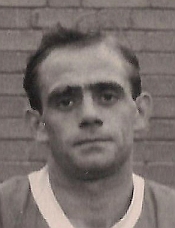
Joe Wallis
The 1955-56 season finished on a high note with the club moving up to 11th thanks in part to 20 goals on the season from Joe Wallis, one of three brothers to play for the club, who had taken Darey’s spot and also to a late flourish from Tony Wright who after being signed from Carshalton Athletic scored seven goals in the last three games.
In 1956 Wimbledon changed their lease terms at Plough Lane, agreeing a new deal at £400 a year. This led in part to the club operating in the red.
The following season featured more mid-table mediocrity and average attendance was a dismal 1,829. During the following season the supporters club decided to build a new clubhouse in the hope that it would attract fans back.

The clubhouse and offices The club also announced a colour change with the blue shirts with white sleeves and black shorts replaced by blue shirts with white trim and white shorts.
Henley’s methods were proving unpopular with some of the players and the three Wallis brothers left. The season was yet another disappointment but it was brightened by the arrival of a player who would lead Wimbledon to their first real glory days.
A team shot with Eddie Reynolds front and centre
Northern Irishman Eddie Reynolds was signed after being released by Tooting & Mitcham where he couldn’t dislodge fellow-countryman Paddy Hasty from the team. His first game, ironically against his former club, was a goalscoring one but it ended in a 4-3 defeat. From there the centre forward just kept on scoring, netting in his first five matches and finishing the season with 17 goals in 20 games.
The young team Henley had built was certainly inconsistent but this time they managed a move up the table slightly. With Chairman Black continuing to both raise and give money to the club – they announced that the North Stand would be rebuilt at a cost of £6,000 – and now with a new star in Reynolds, Dons had a trio in place, one in the boardroom, one in the dugout and one in the pitch, who would bring a new level of success to Plough Lane.
The 1958-59 season was when it all started to come together. Buoyed by more new arrivals, they made a good start.
Early in the season Henley gave a debut to Roy Law in the 5-4 win over Woking. After being in the books of Crystal Palace as an amateur, the defender did his national service before signing for Wimbledon. He was to become a huge figure in the club’s rise.
Good early-season league form was not carried over into the FA Cup where they suffered an early exit at the hands of Dorking.
They opened the new North stand with a match against an Army battalion team, where Brian Rudge impressed for the opponents and was snapped up by the club. Dons followed this with a 1-0 win at Tooting & Mitcham – Reynolds got the goal – to establish themselves close to the top of the table behind early pacesetters Wycombe Wanderers.
The Dons continued to put the leaders under pressure and finally took over at the head of the standings. Eventually it was Dulwich Hamlet who proved Wimbledon’s biggest challengers and the last two games of the season saw the two contenders play each other. Wimbledon needed to win one of the two to clinch the crown and they took care of business at the first opportunity beating their rivals 3-1 with Reynolds, who would finish the season with 37 goals, scoring one of the three.
So, it was a first title for 23 years and the success was underpinned by extremely strong home form. Dons won 14 of 15 league matches at Plough Lane and drew the other.
Eddie Reynolds
The 37 goals scored by Reynolds proved to to be just the start. Over the following six seasons his goals tally would be; 39, 47, 50, 53, 35 and 53 again. A phenomenal strike rate and over the course of his career with the Plough Lane club he totalled 231 goals in 215 league games and 99 in 102 cup matches.
It’s quite amazing, given his record, that Reynolds was never offered a chance at a higher level. But everyone else’s loss was Wimbledon’s gain and he goes down as one of the greatest-ever non-league strikers. His impact and legacy at Plough Lane was such that the development that now stands where the club used to play is called Reynolds Gate.
More work was carried out on the ground in the summer of 1959 with cover being added to the Western side and the reigning champions went into the new campaign confident of a repeat.
Off the pitch, chairman Sidney Black announced that, to celebrate his 50th birthday he had bought the freehold of the ground and was donating it to the club and also gave news that new floodlights were bought and would be installed shortly.
The attempt at retaining the Isthmian title fell short despite Reynolds’ 39 goals as arch-rivals Tooting & Mitcham, who had won five and drawn two of seven games between the two in all competitions during the season, claimed the crown with 42 points. Wycombe Wanderers finished runners-up with Dons in 3rd three points behind the champions.
The 1960-61 season saw the new floodlights used for the first time. Arsenal were the visitors in October for a London Challenge Cup tie and ran out 4-1 winners in front of 8,900 fans.
Mike Kelly
December saw the first-team debut of 18-year-old Mike Kelly in goal. Kelly would go on to win England amateur international honours and, eventually turn professional, moving into league football, first with Queen’s Park Rangers and later with Birmingham City.
The Dons again fell short in the race for the Isthmian crown with another 3rd-place finish. But they had a big say in the eventual outcome. Walthamstow Avenue travelled to Plough Lane needing just a point to secure the title but the match had to be abandoned with no score after 30 minutes due to torrential rain. When the game was replayed Wimbledon ran out 3-2 winners handing the title to Bromley.
The win over Walthamstow was sweet revenge after they had been eliminated from the Amateur Cup at the quarter-final stage by the same team. Early wins over Wycombe Wanderers, Woking and Whitley Bay in a three-match epic set up the last-eight clash with Walthamstow and a crowd of 10,806 were at Plough Lane. But most were to be disappointed as Dons lost by a single goal to an Avenue team that would go on to lift the trophy at Wembley with a 2-1 win over West Auckland Town. This was the second year running that Wimbledon had been ousted by the eventual winners with the previous year’s conquerors Hendon also going on to capture the cup.
But Henley had his side set now, with Kelly, Law (who had by now taken over as captain) and Reynolds, who had found the net 47 times, forming a formidable spine.
The 1961-62 season didn’t start well. Five points from their first seven games plus an F.A Cup exit at the hands of Walton and Hersham didn’t bode well. But then, suddenly they turned things around. With Reynolds banging in goals at an alarming rate, Dons rose up the table.
The 1961 line up
Reynolds was joined up front by winger Les Brown who scored four times on his debut and would go on to capture amateur international honours as did Law, Kelly, Reynolds, Geoff Hamm, Bobby Ardrey, John Martin and Brian Martin.
The season brought another Amateur Cup quarter-final appearance and this time a long journey to play Northern Leaguers Crook Town. On an almost unplayable pitch the home team won 2-0 and went on to lift the trophy, the third time running that Dons had been ousted by the eventual winners.
There was no stopping Wimbledon in the Isthmian as they took the title with three matches to spare eventually claiming their second successive crown by three points from Leytonstone with Reynolds finishing with 50 goals in all competitions. The trophy haul was added to as Dons took the South of the Thames Cup and shared the London Senior Cup with Wealdstone.
Whilst the successes continued on the pitch, off it there were continual improvements with the supporters club room enlarged and the dressing rooms modernised.
All of this was the starter. The main course came with a 1962-63 season that was certainly their finest to-date, and quite possibly, despite the antics of 1987-88, the greatest in the club’s history.
Things began with an F.A Cup run where wins over Leatherhead, Woking, Kingstonian and Oxford City set up a 1st round clash with Third Division Colchester United. Goals from Brown and Reynolds gave Dons a 2-1 win in front of 9,500 fans, their first-ever success over a Football League side.
This set up a 2nd round visit to Bristol City where Dons fell behind 2-0. They fought back, got one back and peppered the Bristol goal but failed to find the equaliser.
Football was almost completely put on hold for two months by the ‘Great Freeze’ and Henley’s side faced a huge backlog of matches when things finally got going again.
An unbeaten league run that started in November and went right through to May saw Dons move to the head of the table and the Amateur Cup began with wins over Southall (after a replay), Chesham United and Barnet to up a quarter-final clash with Bishop’s Stortford. A single Geoff Hamm goal proved enough to see off the Delphian League team and set up a semi against Leytonstone.
The semi was played at Highbury and Dons got revenge for their 1947 final loss to the same rivals at the same venue with a 2-1 win. Goals from Brian Martin and Norman Williams set them on their way and although Leytonstone hit back, the Wimbledon defence held firm to earn them a trip to Wembley.
On Saturday 4 May Les Henley led his team out at Wembley in front of 45,000 fans to face Sutton United.
Dons, with their phalanx of internationals were overwhelming favourites but it was the underdogs who dominated the early stages. Wimbledon held out and the teams played out a goalless first-half with little hint of the goal-fest to come.
Whatever Henley said to his men at half time, it clearly worked. Les Brown’s cross barely a minute into the second period was met by the head of Reynolds and it was 1-0. Nine minutes later Brian Martin was the provider and Reynolds headed his second.
Sutton fought back. Goals from Mickey Goodall and Trevor Bladon levelled the score. But then Reynolds took over again and in the 88th minute got his third headed goal from a Geoff Hamm cross. Finally a fourth different provider, Ted Murphy, crossed and the Northern Irishman headed home yet again, clinching the win.
The team still had the title to wrap up as they chased down Kingstonian. On the final day Dons travelled to Walthamstow knowing anything other than a heavy defeat would clinch the title. They won 1-0 thanks to – you guessed it – a Reynolds header, his 53rd goal of the campaign. It was a fitting end to a remarkable season.
The next season was good too, but couldn’t quite live up to the previous campaign. The Amateur Cup win saw exemption until the 1st Round of the F.A. Cup. However a win against Bexley United was followed by defeat, after a replay, to Malcolm Allison’s Bath City. The attempt to retain the Amateur Cup came to an end with a last-16 defeat at Enfield. The North Londoners would go on to lose to Crook Town in the final.
Defence of the Isthmian League crown was achieved with relative ease with a six-point cushion to the runners-up and Ian Cooke, the man who would eventually take over chief goalscoring responsibilities from Reynolds made his debut. But the big action took place off the pitch as Chairman Sidney Black led the calls for the club to join the paid ranks.
With Clacton Town’s resignation from the Southern League, a place was available and the club held a special meeting in May 1964. A vote was held and the overwhelming majority (by 139 votes to 6) voted to take the next step and apply for a Southern League spot.
Wimbledon were going pro!
Coming soon. Part three of the Plough Lane Story. The Professional Years
For a more in-depth look at Wimbledon’s history visit www.historicaldons.com

